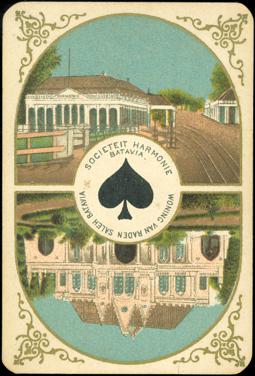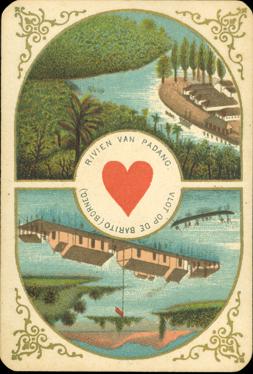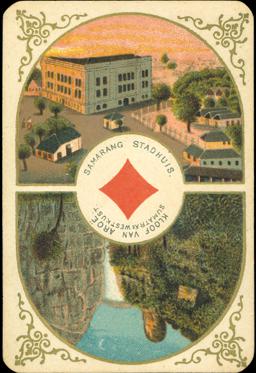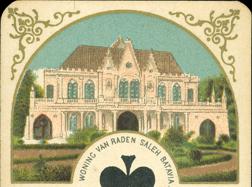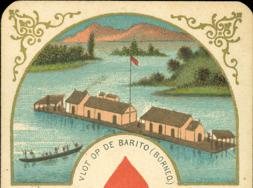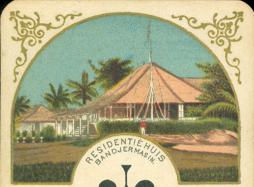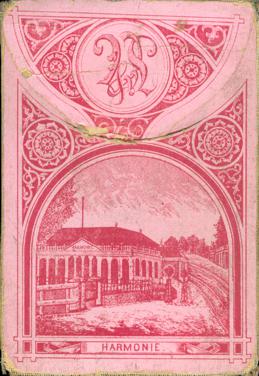March 2013
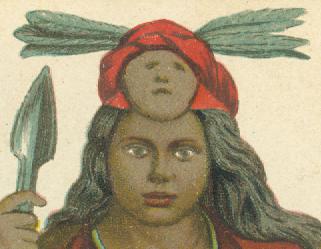 |
We overslept and missed the 10th Int. Spring Fair for playing card
collectors in Lokeren-Daknam, Belgium. So for us there was just one main
event this month and that was the general collectors fair in Utrecht. It
brought us only 2 new decks and they are not even worth mentioning here.
So once again the internet had to supply ammo for our short list: the
cute Odd Bods deck by the Folio Society was one, a rare French deck
from Casablanca and a never seen French patterned deck from Switzerland:
see our "Card of the Month" at the BOTTOM of this page!
|
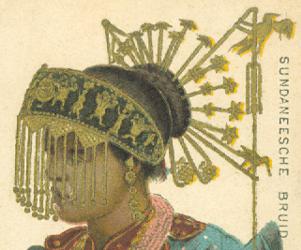
|
|
Our Deck of the Month arrived on the 1st and we were
already convinced that it could not be surpassed this month. This
illustrates our excitement when we first held the deck. We had only seen
it in books, but had never had the opportunity to actually see or hold it.
It's a beauty and a rare one too, so.......... ENJOY!
|
The deck was
printed in fine chromolithography by the Vereinigte Stralsunder
Spielkartenfabriken from Stralsund, Germany, and published by Van Duym &
Co. from Soerabaja (Surabaya) around 1880. We've tried to find out what
the nature of Van Duym & Co.'s business was, but haven't been able to find any information
about that.
The designs are excellent and full of fine
details. Unfortunately the name of the artist (or probably artisan/engraver) is
not known, but he must have used photo's for his designs. In those days
photography was done in black (or sepia) and white and this could explain the only
oddity that we spotted in these fine portraits: 99.9% of the indigenous East
Indian people has dark brown eyes and not blue or gray ones. The designer
apparently had never seen any actual East Indian people and has probably used
the colour of his own eyes for them. At least..... that's our theory.
The suits represent islands: Sumatra on Clubs, Java on Diamonds, Nias on
Spades. Only on Hearts Borneo is represented as well as Sunda (a region of Java).
The
Queens and Jacks represent native people from these islands in the
Dutch East Indies (since 1949 Indonesia). The QC shows a woman from Paya Kombo
(Sumatra),
QH a bride from Sunda, QS a girl from Nias and QD a woman from Java. The JC
shows a man from Padang (Sumatra), the JH a man from the Dajak people (Borneo), JS a chief from
Nias and the JD a man from Java.
But the Kings probably present the reason for this
publication: the status of the Aceh War around 1880. Aceh (or Atjeh in Dutch)
is located at the Northern end of Sumatra. All the Kings represent successful generals of the Dutch
army in the Aceh War, during the period of 1873 - 1881.
|
Above their suit sign is the decoration of "Commandeur
in de Militaire Willems-Orde" (Commander in the Military Order of
William). |
|
 |
|
|
All these generals have been decorated as such and
are depicted wearing this crowned cross on their chest. |
|
|
|
 |
KC - Johannes (Jan) van Swieten (1807-1888)
started his military career in 1824 and had already served in different
ranks in the Dutch East Indies. In 1862 he resigned as commander in
chief of the Dutch armed forces there. In 1873 he was reinstated to lead
the second Dutch military raid against Aceh. In January 1874 he
captured the sultans palace and thought that the war would be over. He
returned to Java with the main force and left a small occupying force
behind. He also left instructions for a defensive policy against
the Acehnese people and forces. Jan van Swieten was honorably discharged in July 1874.
|
|
|
KH - Gustave Marie Verspyck
(1822-1909) had already been in command, as a general, of the
Dutch forces in Borneo and was thought to lead the second military raid.
But he was passed, when Jan van Swieten was appointed as commander in
chief. Still, he did the honorable thing and lead the second military raid
as second commander in chief, although he strongly disagreed with the
tactics of general Van Swieten. He too was honorably discharged in July
1874. Van Swieten's decision to withdraw the main force
turned out to be wrong one, just like his soft policy towards the Acehnese. King William III recognized Verspyck's military loyalty and better
judgment of the situation in Aceh by awarding him several decorations and
high positions, after his return to the Netherlands.
|
 |
|
|
|
|
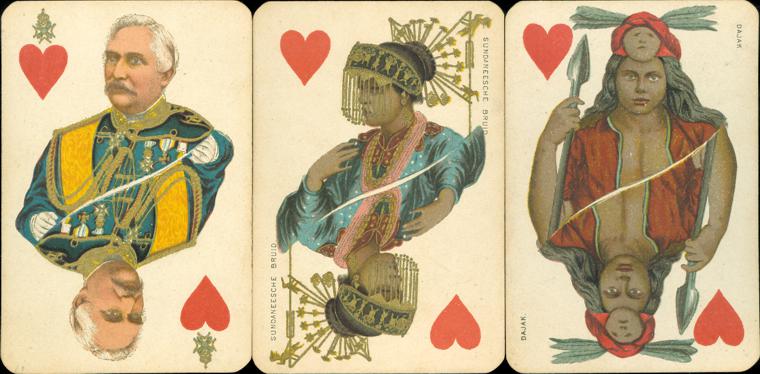 |
|
In 1824 a treaty was signed between the United Kingdom and
the Netherlands, in which the Dutch had taken on the obligation to safeguard
passengers sailing along the coast of Sumatra, but also the obligation to
respect the free state of Atjeh. In 1871 a new treaty was signed, which gave the
Netherlands a free hand in Aceh. The sultanate of Aceh had rich agricultural soil, where peppers and spices were grown, and it
was a well respected region of Sumatra. So besides merchandise, there was
prestige to gain too.
But because Aceh controlled the Strait of Malacca and because that passage had
become more important because of the opening of the Suez canal, there was also a
strategic reason to intervene in Aceh: the Acehnese often acted as pirates
and looted passing merchandise ships.
In 1873 the Dutch government officially declared war against the Aceh
sultanate and a first expedition force was send in April 1873. It wasn't a
successful one and in November 1873 a second expedition force was send.
All the depicted generals were active in the Aceh region between 1873 and 1881,
when a civil government could replace their military one and, although the Dutch
didn't control the whole region, a relatively peaceful period had begun. That
period ended again in 1883, when the war between the troops of the sultan and
the Dutch had begun over an escalated knidnapping of British citizens from a
stranded ship in a part of the region that the Dutch didn't control. The war
dragged on and officially ended in 1903.
|
The logo of the Vereinigte Stralsunder
Spielkartenfabriken is on the King of Spades. |
|
|
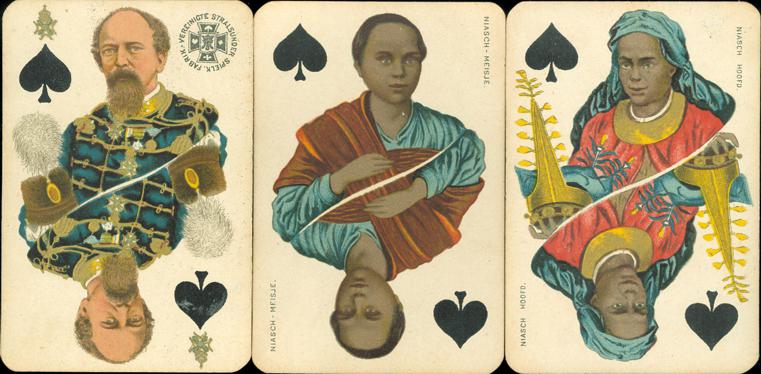
|
|
|
|
|
 |
KS - Johannes Ludovicius Jakobus Hubertus (Johan) Pel
(1823 - 1876) had the rank of colonel, when he was as appointed military
commander of Aceh in February 1874, after Van Swieten had left with the
main force. His orders were to maintain and not attack, but the
situation changed drastically after the main force had left and Pel
decided for a more pro-active defense. He safeguarded the sultans palace
and build a line of defense, withstanding the fierce attacks by the Acehnese troops. In November 1875 he was promoted to general and during a
successful raid he died as result of a ruptured artery -at night.. in bed..
in a small Aceh hut- on February 23, 1876.
|
|
|
KD- Karel van der Heijden (1826-1900) also was a
colonel when he was appointed civil and military commander of Aceh in
June 1877. Under his regime the Acehnese returned to the kampongs
and rice fields, surrendering their weapons and ammunition. Although peace
was restored in Aceh, the governor-general in Batavia convinced the
Dutch government, that Van de Heyden's regime was too harsh on the
native people. In March 1881 the Dutch government released him of his
task. He returned to the Netherlands in May 1881 and came close to being
prosecuted for cruelties against the Aceh people, but was honorably
discharged and a few months later appointed as commander of Bronbeek, a
military home for retired soldiers in the Netherlands.
|
 |
|
|
|
|
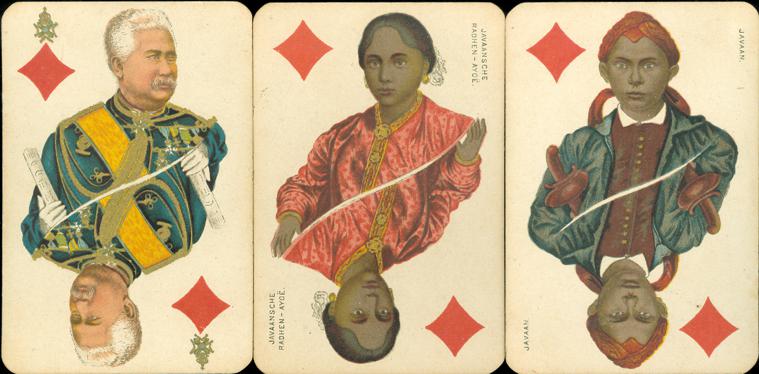 |
|
|
|
|
|
On the backs,
together with the name of the Van Duym & Co. firm and their logo at the
bottom, the shield of
Soerabaja (Surabaya) is depicted. It refers to the mythical fight between a shark ("sura" or
"soro") and a crocodile ("boyo"), which are said to have
given their names to the city.
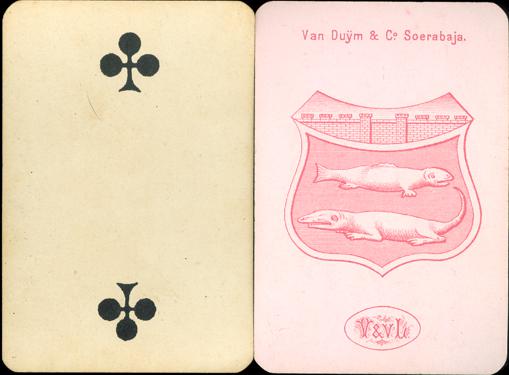
On the box there are two illustrations. The first shows the Societeit Harmonie
in Batavia, the second Jan Pietersz Koen, the founder of Batavia. Maybe the
choice for the first illustration reveals the reason for the publication. After
decades of war the East Indies seemed to be in peace and harmony ("Harmonie" in
Dutch) in 1881. Business could prosper again and maybe the deck was
commissioned by this firm to express their gratefulness by honoring the
men who had created this status quo.
"CARD OF THE MONTH"
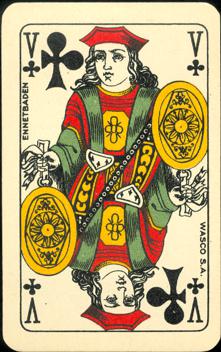 |
We found
this deck on Ebay. Maybe it was the coloring, but there was something
in the thumbnail to make us take a closer look at the item. And now we're
glad we did. This Jack of Clubs was shown too and nor the name of the
maker nor the name of the place rang a bell here. We bought the
double deck. It has a standard French pattern, in which the designs
are quite close to the original, although there are differences in the
coloring of the courts. However, when we started researching these
names a tragic story presented itself about a man, who had one thing
against him in life: he was of Jewish descent.
Walter Scharff was born in Landau, Germany, in 1893. He had finished
the Gymnasium and had served in the German army during WW I, when he
started working in Graphia, a Munich print shop. In 1919 he became a
co-owner of the Heinrich Spindler paper mill. In 1923 he founded the
"Deutsche Spielkarten-Fabrik A.G.", which was renamed into
"Deutsche Spielkarten-Fabrik Walter Scharff K.G." in 1925.
In 1928 the company was taken over by the VASS, then the largest
producer of playing cards in Germany, and Walter Scharff became a
member of the board of directors there. His former company became a
sales office, the cards were printed by the VASS.
In 1931 a small Swiss printer, Atrac AG, went bankrupt in Ennetbaden.
It was taken over by Walter Scharff and in 1932 continued under the
name WASCO AG. Scharff himself still resided in Germany at that time.
In 1933 Hitler and his national-socialist party gained power in
Germany and their anti-Semitic policies led to the dismissal of
Scharff from the board of directors at the VASS in 1936. That same
year Walter Scharff left Germany, together with his wife and
daughter, and went to Switzerland. There he sold the WASCO AG to J. Müller
& Co. and with the revenues he went to Egypt in 1936. His family
followed in 1937.
|
|
In 1938
he founded a modern printing shop and playing card factory in
Alexandria. His cards became famed all over Egypt and were even used
at the royal palace of King Farouk. But after the nationalist
revolution of 1953 the new Republic of Egypt took an anti-Semitic road
and the "Zionist" properties were nationalized one by one
and Jewish people left the country. In 1948 there was a Jewish
population of 48.000 in Egypt and in the mid 1960's there were only
around 1.000 left. Walter Scharff and his wife left the country in
1962 and they went back to Switzerland. He died there in 1967 in poor
circumstances. |
UP or BACK TO PRESENT MONTH





